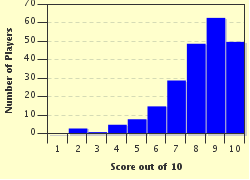Quiz Answer Key and Fun Facts
1. When Little Jack Horner sat in the corner, what was he eating?
2. Why did Old Mother Hubbard go to the cupboard?
3. Fill in the missing word. "Mary, Mary, quite contrary, _____ does your garden grow?"
4. Why did Tom, the piper's son, run away?
5. Why did Polly put the kettle on?
6. Where did Mary's lamb follow her?
7. In "Jack and Jill", who fell down the hill?
8. What was Wee Willie Winkie wearing when he ran through the town?
9. In "Hey Diddle Diddle" who was laughing at all the fun?
10. Where were Little Boy Blue's sheep?
Source: Author
boof123
This quiz was reviewed by FunTrivia editor
looney_tunes before going online.
Any errors found in FunTrivia content are routinely corrected through our feedback system.

